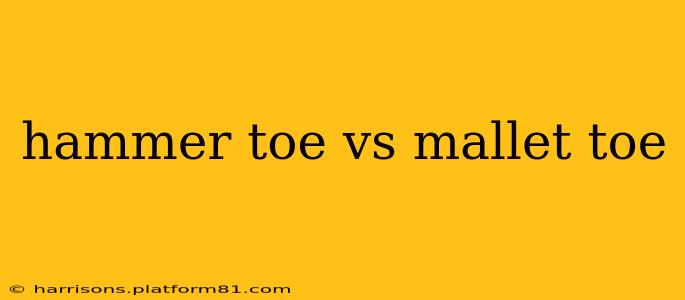Hammer toe and mallet toe are both deformities of the toes, characterized by a bent or crooked appearance. While they share similarities, understanding their key differences is crucial for proper diagnosis and treatment. This article will delve into the distinctions between hammer toe and mallet toe, exploring their causes, symptoms, and available treatment options.
What is Hammer Toe?
Hammer toe is a deformity affecting the second, third, or fourth toe (less commonly the fifth). It's characterized by a bend or contracture in the proximal interphalangeal (PIP) joint – the joint in the middle of the toe. This causes the toe to bend downwards, resembling a hammer. The distal interphalangeal (DIP) joint, the joint closest to the toenail, may also be affected, but usually less severely than the PIP joint. The toe’s overall appearance is often bent at two joints.
Causes of Hammer Toe
Several factors contribute to the development of hammer toe, including:
- Ill-fitting shoes: Tight, narrow shoes are a significant culprit, constricting the toes and forcing them into unnatural positions over time.
- Muscle imbalance: An imbalance in the muscles controlling toe movement can lead to abnormal bending.
- Rheumatoid arthritis: This inflammatory condition can affect the joints in the toes, causing deformities like hammer toe.
- Neurological disorders: Conditions affecting nerve function in the feet can also contribute to hammer toe development.
- Genetics: A family history of hammer toe increases the risk.
What is Mallet Toe?
Mallet toe is a similar but distinct deformity affecting the toe. The key difference lies in the affected joint: in mallet toe, only the distal interphalangeal (DIP) joint—the joint closest to the toenail—is bent. The toe bends downwards at the tip, resembling a mallet. The PIP joint remains relatively straight.
Causes of Mallet Toe
Similar to hammer toe, mallet toe can result from:
- Ill-fitting footwear: Constricting shoes are a common cause.
- Injury: A previous injury to the toe can sometimes contribute.
- Rheumatoid arthritis: As with hammer toe, this condition can lead to joint deformity.
- Trauma: Severe injury to the toe can damage the tendons or ligaments, resulting in mallet toe.
Hammer Toe vs. Mallet Toe: A Comparison Table
| Feature | Hammer Toe | Mallet Toe |
|---|---|---|
| Affected Joint | Proximal interphalangeal (PIP) joint (primarily), often DIP joint as well | Distal interphalangeal (DIP) joint only |
| Toe Appearance | Bent at the middle joint, sometimes also at the tip | Bent only at the tip |
| Commonly Affected Toes | 2nd, 3rd, 4th toes | 2nd, 3rd, 4th, and sometimes 5th toes |
| Causes | Ill-fitting shoes, muscle imbalance, arthritis, neurological disorders, genetics | Ill-fitting shoes, injury, arthritis, trauma |
How are Hammer Toe and Mallet Toe Treated?
Treatment options for both hammer toe and mallet toe depend on the severity of the deformity and the presence of any associated symptoms like pain or calluses. Options include:
- Conservative Treatment: This often involves wearing wider, more comfortable shoes, using toe separators or padding to alleviate pressure and reduce pain, and performing stretching exercises.
- Orthotic Devices: Custom-made orthotics can help support the affected toe and improve its alignment.
- Surgery: In severe cases where conservative measures fail to improve the condition, surgery may be necessary. Surgical options include tendon transfers, joint fusion (arthrodesis), or removal of a portion of the bone.
What are the complications of untreated hammer toe and mallet toe?
Untreated hammer toe and mallet toe can lead to several complications, including:
- Pain and discomfort: The bent toe can rub against shoes, causing pain and discomfort.
- Calluses and corns: Pressure points on the bent toe can lead to the development of calluses and corns.
- Infections: Skin breakdown from pressure and friction can increase the risk of infection.
- Limited mobility: The deformity can restrict toe movement and affect overall foot function.
- Joint stiffness: Over time, the affected joints may become stiff and difficult to move.
Can I prevent hammer toe and mallet toe?
While not all cases are preventable, you can significantly reduce your risk by:
- Wearing properly fitting shoes: Choose shoes that are wide enough to accommodate your toes comfortably. Avoid high heels and pointed-toe shoes.
- Maintaining foot health: Practice regular foot care, including keeping your feet clean and dry.
- Treating underlying conditions: If you have conditions like arthritis or neurological disorders, manage them effectively to help prevent joint deformities.
This article provides general information and should not be considered medical advice. If you suspect you have hammer toe or mallet toe, consult a podiatrist or other healthcare professional for proper diagnosis and treatment.
